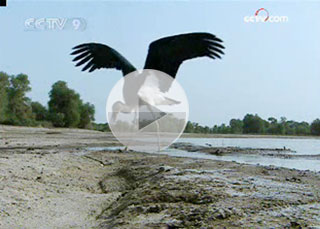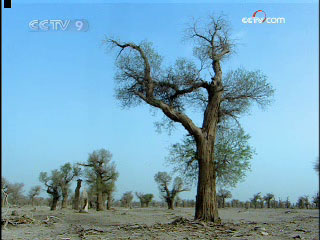------Program code: NS-080811-02077 (what's this?)
Source: CCTV.com
08-11-2008 09:37
Flowing viviparous seedlings are dormant. They don’t conduct photosynthesis, but just wait until they come into contact with silt. Once they reach a beach, they will take root.
 |
The Taklimakan Desert has the world’s finest sand. As for the seeds of the Euphrates poplar, they weigh just one ten thousandth of a gram, and are blown easily by the wind.
Every autumn, when the Tarim River floods, billions of seeds will be sent out by the Euphrates poplars, to search for a river in the vast desert.
 |
But the seeds have just one week to complete their mission.
A seed has a one in a billion chance of growing into one of the tallest trees in the desert.
There’s another tree, the life of which is the stuff of legend. The silver fir is called the Fir King by the local people, and is over 300 years old. It stands alone in a crag on Mount Yuecheng, 1,400 metres up. Fossil finds prove that silver firs extended across Eurasia 4 million years ago. Before the discovery of the Fir King, scientists had thought the silver fir had been made extinct during the Ice Age 2 million years ago.
The silver fir produces new needle leaves in spring. The two strips of white air holes on the backs of the leaves form its breathing organ, which is quite unlike that of any other fir tree.
The temperature rises. With the wind’s help, the male flowers sprinkle mature pollen in the air. Meanwhile, the female flowers on the same tree complete the mating process in this pollen rain.
From the formation of the silver fir’s germ cell to the maturing of the seed will take 31 months. This will include 2 winters and 2 dormant periods. This lengthy procreative period is thought to be a legacy from before the Ice Age.
There's nowhere else in the world today, other than the virgin forest on the eastern edge of the Yunnan-Guizhou Plateau, where as many as 4000 silver firs can be found in one place. Most of the trees are old; there are few younger members of this community. The forest is a phenomenon – one that is attracting increasing attention in biologists’ circles.
The silver fir’s existence is closely related to the high mountains and deep valleys of the Yunnan-Guizhou Plateau. The plateau is the second transitional step from the Tibetan Plateau, eastwards. Here, the series of basins, valleys and Karst highland protected the ancient plants from the effects of the Fourth Ice Age. A number of animals were also saved from harm. Besides the silver fir, the other survivors here include such living fossils as hemlock, the Fujian cypress, the Java podocarpus and the liriodendron.
Numerous animals also benefit from the complex landform of the Yunnan-Guizhou Plateau.
The ancestors of the silver pheasant - also known as the silver chicken – could fly. But food was so readily available that with time their wings degenerated. They just have to wait on the ground for the food to come.
This is home also to an ancient mammal, the flying squirrel. A close relative of the common squirrel, it is set apart from other mammals by its ability to glide.
On China’s territory, the forests are all seasonal, with the exception of a small part of the tropical rainforest. Because the forests change with the season, their inhabitants have to alter their diet accordingly.
The Qinling Mountains form a natural geographical line dividing China into north and south. Extending for over 800 kilometers, they halt the cold front from the north and draw in the southeast monsoon from the Jianghan River. The Qinling Mountains are also a divide between the Yangtze and Yellow Rivers. On the southern and northern slopes, there is a great contrast in scenery, between semi-tropical and warm temperate. The abundant vegetation turns it into a unique highland wildlife paradise.
The crested ibis finds fish and loaches in the streams and ponds. In spring, their mating calls can be heard at the foot of the mountain.
